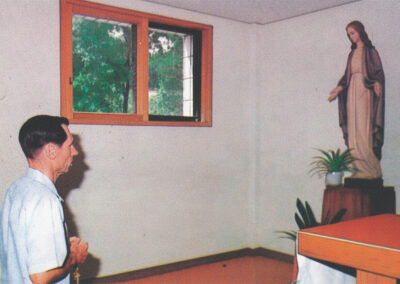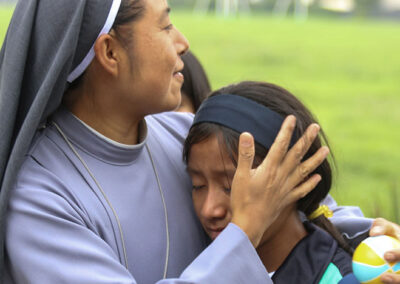
Fr. Al taking a walk with the Sisters of Mary.
At the closing of his life, when his diseased body was days from surrendering its long fight with ALS, Fr. Al’s thoughts were on his Carmelite muse. With his eternal homeland in view, his thoughts on his withered body, wracked pain and fear of choking to death were set aside for his tender Little Flower.
It is guessed that Fr. Al had read St. Therese of Lisieux’s autobiography, The Story of a Soul, well over a dozen times. Each Sister of Mary nun has read the Little Flower’s spiritual autobiography. “Therese herself has put [the book] into my heart, my bloodstream, and the very marrow of my bones,” he once told Mother Gertrude, a Belgian Carmelite nun whom Fr. Al considered his spiritual mother and lifelong prayerful intercessor.
Days from death, Fr Al spoke in a barely audible whisper into a voice recorder. One could barely understand him through his labored words. After blithely describing how he “made the acquaintance” of St. Therese at minor seminary at the age of 16, Fr. Al suddenly fell into a tender soliloquy.
“Therese, I thank God for giving you to the Church and to me,” he said. “You call yourself Little Flower but you are the most beautiful, fragrant, exquisite rose in God’s mystical garden. Truly you are a miracle of God, a beautiful jewel, you are one of his most precious masterpieces.
“Therese, I love you dearly. I am so grateful for your inspiration and your help in my moment of need.”

Fr. Al in his final months of life.
As his body deteriorated, he looked with a supernatural vision at her cheerful face. He had given over his life to The Lady of Banneux and accepted the violence of his unrelenting schedule to crucify himself with Christ. He fell into awe at the thought of majesty of God and begged the intercession of Saints Theresa of Avila, John of the Cross, John Bosco, Francis of Assissi and even Patrick.
But throughout his life, when his thoughts turned to his Little Flower, he fell into a different spiritual dimension. At the end, when he had lost possession of virtually all of his physicality, his soliloquy grew intense, candid and mystical. He spoke aloud to his muse, as if the French saint was still alive and resting in a hospital bed beside him. Therese had died of tuberculosis at the age of 24.
“I secretly envy you,” Fr. Al said. “No doubt your pain is horrible. … you are a saint and a hero. I struggle and huff and puff and try my best, but I simply am not on your level. It is like comparing two marathon runners. One easily completes the course … with a minimum of pain. The other, myself, completes the same course … and the pain is much greater because by nature, talent and training I am much less prepared.”
Why do I bring up the intensity of this relationship in this writing? Why bring up the final days of Fr. Al’s life. Because similar to the Little Flower who promised to shower her love on humankind by creating miracles from heaven, Fr. Al, too, vowed to the Sisters of Mary that he would never leave them. He promised he would help to sustain what he called “The Unfinished Symphony” after his death.

Sr. Maria recovering from her injury, alongside Sr. Margie.
Two months ago in Chalco, Mexico, I spent two weeks at the site of Girlstown. Just prior to my arrival, an elderly nun, Sr. Maria, fell from a moving cart on her birthday. She had been helping to deliver food when her head slammed up against the pavement. Her brain instantly began to hemorrhage. At the hospital she fell into a coma and doctors shared that her prognosis was grave. She wasn’t expected to live. Blood was drowning her brain and surgeons could do little to control its heavy flow.
One morning, Sr. Margie Cheong, the head of the Latin American Communities, approached me by a profusion of flowers in one of the gardens she tends. She shared with me that each of the Sisters were praying for a miracle of healing. This Korean sister, who had given more than 40 years of service to the order, was cherished by many hundreds of sisters and tens of thousands of children over the years for her steady offering of humble self-sacrifice. She scrubbed toilets in public bathrooms and tidied cabinets no one thought to tidy. She spotted the crumbs in the kitchen corner that no one saw. She had built her life around making unseen acts of sacrifice.
Because each sister loved Sr. Maria dearly, many began to fast for her. To model and honor her life, they began to offer unseen gifts of sacrifice and mortification. Each called on Fr. Al, Save Sr. Maria, they begged.

Prayer intentions asking for the intercession of Fr. Al left on the wall of his room.
Two days before I caught a plane back to America, Sr. Margie asked that I meet her by that same garden. I waited beneath the shade of an old tree.
Sr. Margie slowly approached. She was pushing Sr. Maria in a wheelchair. Beneath Sr. Margie’s mask, I could see a mile-wide smile.
“Sr. Maria is healing now,” Sr. Margie said. “And every day she gets a little better. I believe it is a miracle from Fr. Al. And it is a direct mercy from God.’

Sr. Maria recovered after receiving many prayers from her fellow Sisters and the children.
Today, Sr. Maria is back to work and caring for the children. She gives a “thumbs-up” to passers-by. All is well. God is good. She is set to return to her homeland to further regain her strength with intensive therapy. She is filled with joy today.
The secret of Chalco – and of all World Villages for Children communities throughout the world – involves a belief in the invisible, in the supernatural realm that so much of the world has abandoned. The secret of Chalco is Fr. Al’s promise never to depart.
It just takes faith. That’s all.





